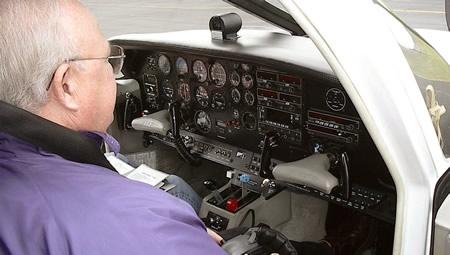3-Day Commercial Pilot Certification Course
Many pilots tend to believe that only those who fly for a living need Commercial certification, but there are many benefits to obtaining higher-level type certifications. Proficiency tops the list.
Many past Commercial students use the course as a way to keep current and continue learning. Not only can you advance your skills as a pilot, but you can also get something besides time in your book!
The training you complete to become a Commercial pilot takes you a step beyond the average Private pilot. You'll earn a better understanding of aircraft systems, aerodynamics, airspace, etc. The maneuvers such as chandelles, lazy eights, and eights on pylons are not outdated maneuvers without meaning. They are all designed to teach you to properly divide your attention between the outside references and inside the cockpit. This is a skill that some pilots have never truly mastered. These maneuvers are referred to as ”maximum performance” maneuvers, meaning you learn to control the aircraft at its operational envelope. The benefit is a steep increase in positive control over the aircraft. Pilots learn they can control the aircraft to do what they want, when they want. Basically, you will become a more knowledgeable and polished pilot. The more knowledgeable and proficient you are, the larger your safety margin becomes!
There are other benefits as well. Because of the higher degree of education and proficiency, you may receive fairly sizable discounts on your insurance premiums. If you think that you might someday be interested in becoming a flight instructor, you'll first need to obtain your Commercial certification as well. Keep training, keep learning and remember: Being a “part-time” pilot doesn't mean that you can’t fly with professional abilities.
Benefits: Safety through proficiency. Proficiency through education and training. Decreased insurance premiums.
Class Note: 3 days instruction (checkride on the 4th day). All-inclusive course packages.
Prerequisites
- Pilots must have a current BFR and medical.
- Pilots must have flown a minimum of 5 hours in the past six months or 15 hours in the past year.
- Pilots must have the commercial written passed upon arrival.
- A minimum of 240 hours total time with the following Pilot In Command Cross Country time logged:
- one cross-country of 2 hours in a single-engine airplane in day VFR conditions of a total straight line distance of more than 100 nm from the departure point (dual with instructor);
- one cross-country of 2 hours in a single-engine airplane in night VFR conditions of a total straight line distance of more than 100 nm from the departure point (dual with instructor);
- 10 hours of solo flight in a single-engine airplane on a Commercial Pilot areas of operation that includes one cross-country flight of not less than 300 nm. with landings with a minimum of 3 points, one of which is a straight line distance of more than 250 nm. and 5 hours in night VFR conditions with ten takeoffs and ten landings at a controlled airport
CHECK FAR’S FOR DETAILS OR ANY QUESTION ABOUT THESE CROSS COUNTRY REQUIREMENTS. THESE ARE FAA REQUIREMENTS TO OBTAIN A COMMERCIAL CERTIFICATION, NOT JUST GATTS PREREQUISITES TO START A COURSE. PLEASE NOTE: THIS IS SIMPLY A BASIC LIST. ALL REQUIRED CROSS COUNTRY FLIGHTS, NIGHT TIME HOURS AND TAKE OFFS AND LANDINGS MUST BE COMPLETED PRIOR TO TAKING THIS COURSE. HOWEVER, AS AN INDIVIDUAL WHO IS WANTING TO OBTAIN AN ADVANCED, FAA, PILOT CERTIFICATION SUCH AS THE COMMERCIAL PILOT CERTIFICATION, IT IS YOUR RESPONSIBILITY TO KNOW THE FAA REQUIREMENTS OF OBTAINING THAT CERTIFICATION PRIOR TO THE CHECK RIDE.

